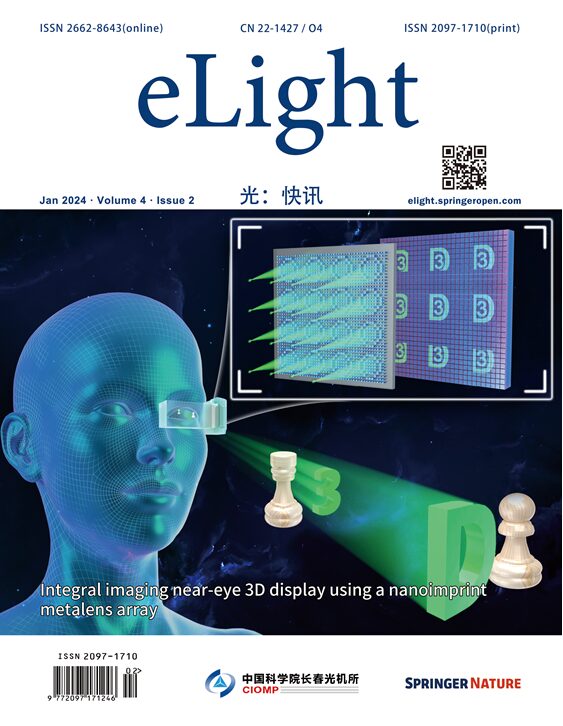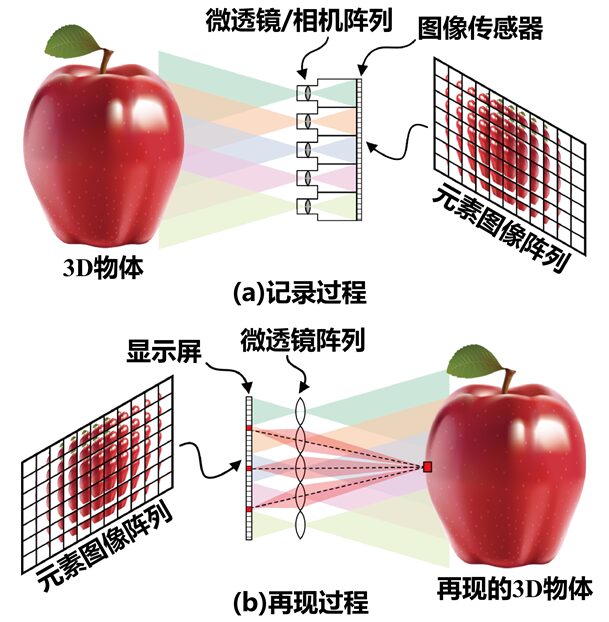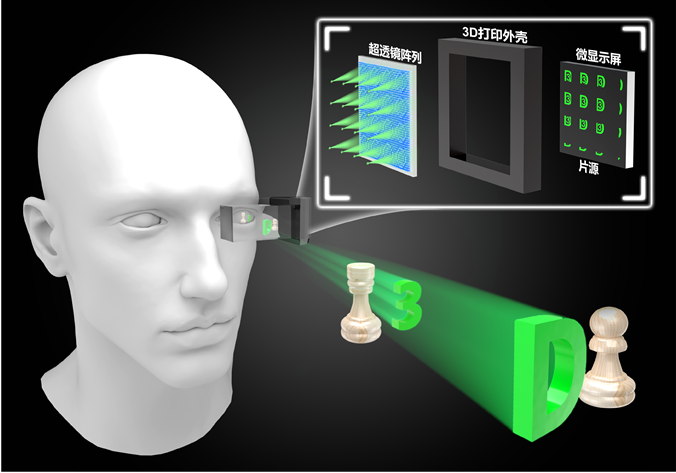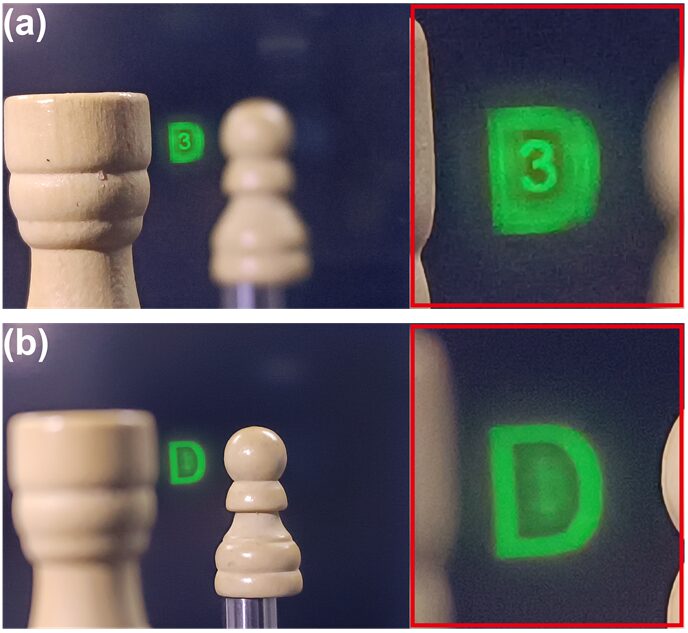
Banner

Introduction
Professor Dong Jianwen and Associate Professor Qin Zong from Sun Yat-sen University reported an integrated imaging near-eye 3D display module based on a meta-lens array. This module adopts a novel architecture that combines a nanoimprint meta-lens array, a high pixel density microdisplay, and a low-complexity real-time elemental image source algorithm, demonstrating a video-level true 3D near-eye display with perspective AR effects. It features monocular focus depth cues, eliminating the vergence-accommodation conflict for the human eye, and will aid the application development of metamaterials in next-generation VR/AR fields.
This achievement was published in the journal eLight, titled “Integral Imaging Near-Eye 3D Display Using a Nanoimprint Metalens Array.”
Integrated Imaging Near-Eye 3D Display
Integral Imaging 3D Display (Integral imaging, II) features full color, full parallax, quasi-continuous light fields, and hardware feasibility. More importantly, it can achieve true 3D display and more realistic depth perception by eliminating the vergence-accommodation conflict (VAC), making it one of the most promising true 3D display technologies. The integral imaging technology includes a recording process and an image reproduction process: the recording process typically samples the spatial and angular information of light emitted by objects simultaneously through a micro-lens array, and the recorded image is referred to as an elemental image array (EIA). Currently, elemental image arrays are mostly generated through computer ray tracing using specific elemental image source algorithms. When the elemental image array is loaded onto a microdisplay, the principle of optical reversibility allows the micro-lens array to reconstruct the light emitted by 3D objects, thus reproducing a true 3D image.

Figure 1: Schematic Diagram of Integral Imaging Principle
The traditional optical architecture of integrated imaging near-eye 3D displays usually employs a micro-lens array as the core light-controlling element, which is limited in resolution, field of view, and depth of field. Particularly, with the development of existing commercial microdisplays, the pixel density of screens is increasing, which also demands more precise light control capabilities from the light-controlling elements. However, traditional optical architectures based on micro-lens arrays face significant technical bottlenecks in pixel-level light field modulation. Metamaterials have the potential to break through these bottlenecks. The meta-lens array, as a new type of ultrathin planar optical element, is a two-dimensional planar nano-array composed of many sub-wavelength micro-nano structures arranged in a specific manner according to specific functional needs, offering unprecedented design flexibility and allowing pixel-level light field manipulation in amplitude, phase, and polarization dimensions. The new integrated imaging near-eye 3D display architecture based on the meta-lens array (referred to as the Meta-II near-eye display architecture) is expected to advance to the next generation of virtual reality (VR) and augmented reality (AR) by creating a more immersive experience.
However, to realize the aforementioned new Meta-II near-eye display architecture and break the constraints imposed by traditional optics, several key technical issues still need to be addressed. First, the meta-lens array, as a key light-controlling device of the Meta-II near-eye display, must match the high pixel density of existing commercial microdisplays in terms of focusing resolution, and its light-controlling area must also match the size and optical extent (etendue) of commercial microdisplays. Currently, the meta-lens arrays are too small to be integrated with existing commercial microdisplays. The realization of large-area meta-lens arrays requires high-precision nanofabrication techniques, designed specifically according to their material and process linewidths, and the development of nanoimprint technology provides a good candidate. Second, the elemental image rendering algorithm of the integral imaging display requires ray tracing calculations for each viewpoint, which can be computationally intensive. Currently, GPU-based parallel computing is commonly used to accelerate real-time rendering. However, near-eye displays have a very high demand for convenience, especially for high-resolution wearable near-eye displays, making it challenging to apply GPU-based computing platforms. Therefore, to achieve video-level Meta-II near-eye displays, the optimization of the integral imaging algorithm is also essential. Fortunately, recent advances in nanofabrication and integral imaging algorithms provide the feasibility for the realization of Meta-II near-eye displays. With the resolution of these fundamental issues, Meta-II near-eye displays are expected to develop rapidly, providing a more realistic virtual reality experience and promoting the development of VR/AR display fields.

Figure 2: Schematic Diagram of Integrated Imaging Near-Eye 3D Display Based on Meta-Lens Array
Integrated Imaging Near-Eye 3D Display Based on Meta-Lens Array
To address the above issues, the team of Professor Dong Jianwen and Associate Professor Qin Zong from Sun Yat-sen University has achieved a new Meta-II near-eye 3D display architecture, combining metamaterials and integral imaging displays for the first time. They developed the Meta-II near-eye display module and applied it to the near-eye display field. This Meta-II near-eye display module mainly includes a high pixel density commercial microdisplay and a large-area meta-lens array. The meta-lens array is fabricated using high-precision large-area nanoimprint technology, employing high-refractive-index imprinting materials with a minimum linewidth of less than 100 nm and a structural thickness of about 500 nm. Compared to electron beam lithography, nanoimprint technology can quickly mass-produce samples of meta-lens arrays, especially large-area samples. This low-cost large-area nanoimprint manufacturing process also makes large-scale production of metamaterials possible. To match this Meta-II near-eye display architecture, the team developed a new real-time rendering algorithm that achieves an average frame rate of 67 FPS without using additional computing devices such as GPUs, utilizing an invariant voxel-pixel mapping relationship. The Meta-II near-eye display module achieves perspective depth adjustment effects by merging 3D images with surrounding objects, demonstrating its broad potential in the AR field.

Figure 3: 3D Rendering of Meta-II Near-Eye Display Module
Future Prospects
The research team has pioneered the combination of meta-lens arrays, microdisplays, and integral imaging algorithms to develop a true 3D display Meta-II near-eye display. Notably, the design flexibility of the meta-lens array is expected to solve several long-standing issues in traditional optical architectures. For instance, a clear 3D image for true near-eye displays needs to cover the “personal space” from several centimeters to several meters away from the user, while the optical depth of field of traditional micro-lens array architectures is very limited. In contrast, the meta-lens array can utilize its polarization multiplexing light field control characteristics to greatly extend the depth of field. Moreover, the Meta-II architecture can provide a feasible solution for near-eye display field of view expansion, precisely compensating for aberrations in large-angle imaging through the free phase design of the meta-lens array. More importantly, compared to the Meta-II proposed in this study, the depth of field extension and field of view expansion do not increase additional complexity and costs in terms of computational complexity, system volume, and component fabrication. In summary, meta-lens arrays will contribute to the next generation of true 3D near-eye displays.
Paper Information